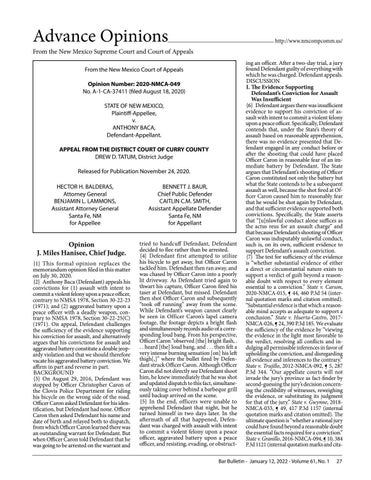Advance Opinions
http://www.nmcompcomm.us/
From the New Mexico Supreme Court and Court of Appeals From the New Mexico Court of Appeals Opinion Number: 2020-NMCA-049 No. A-1-CA-37411 (filed August 18, 2020) STATE OF NEW MEXICO, Plaintiff-Appellee, v. ANTHONY BACA, Defendant-Appellant. APPEAL FROM THE DISTRICT COURT OF CURRY COUNTY DREW D. TATUM, District Judge Released for Publication November 24, 2020. HECTOR H. BALDERAS, Attorney General BENJAMIN L. LAMMONS, Assistant Attorney General Santa Fe, NM for Appellee
Opinion J. Miles Hanisee, Chief Judge. {1} This formal opinion replaces the memorandum opinion filed in this matter on July 30, 2020. {2} Anthony Baca (Defendant) appeals his convictions for (1) assault with intent to commit a violent felony upon a peace officer, contrary to NMSA 1978, Section 30-22-23 (1971); and (2) aggravated battery upon a peace officer with a deadly weapon, contrary to NMSA 1978, Section 30-22-25(C) (1971). On appeal, Defendant challenges the sufficiency of the evidence supporting his conviction for assault, and alternatively argues that his convictions for assault and aggravated battery constitute a double jeopardy violation and that we should therefore vacate his aggravated battery conviction. We affirm in part and reverse in part. BACKGROUND {3} On August 29, 2016, Defendant was stopped by Officer Christopher Caron of the Clovis Police Department for riding his bicycle on the wrong side of the road. Officer Caron asked Defendant for his identification, but Defendant had none. Officer Caron then asked Defendant his name and date of birth and relayed both to dispatch, from which Officer Caron learned there was an outstanding warrant for Defendant. But when Officer Caron told Defendant that he was going to be arrested on the warrant and
BENNETT J. BAUR, Chief Public Defender CAITLIN C.M. SMITH, Assistant Appellate Defender Santa Fe, NM for Appellant tried to handcuff Defendant, Defendant decided to flee rather than be arrested. {4} Defendant first attempted to utilize his bicycle to get away, but Officer Caron tackled him. Defendant then ran away, and was chased by Officer Caron into a poorly lit driveway. As Defendant tried again to thwart his capture, Officer Caron fired his taser at Defendant, but missed. Defendant then shot Officer Caron and subsequently “took off running” away from the scene. While Defendant’s weapon cannot clearly be seen in Officer Caron’s lapel camera footage, the footage depicts a bright flash and simultaneously records audio of a corresponding loud bang. From his perspective, Officer Caron “observed [the] bright flash, . . . heard [the] loud bang, and . . . then felt a very intense burning sensation [on] his left thigh[,]” where the bullet fired by Defendant struck Officer Caron. Although Officer Caron did not directly see Defendant shoot him, he knew immediately that he was shot and updated dispatch to this fact, simultaneously taking cover behind a barbeque grill until backup arrived on the scene. {5} In the end, officers were unable to apprehend Defendant that night, but he turned himself in two days later. In the aftermath of all that happened, Defendant was charged with assault with intent to commit a violent felony upon a peace officer, aggravated battery upon a peace officer, and resisting, evading, or obstruct-
ing an officer. After a two-day trial, a jury found Defendant guilty of everything with which he was charged. Defendant appeals. DISCUSSION I. The Evidence Supporting Defendant’s Conviction for Assault Was Insufficient {6} Defendant argues there was insufficient evidence to support his conviction of assault with intent to commit a violent felony upon a peace officer. Specifically, Defendant contends that, under the State’s theory of assault based on reasonable apprehension, there was no evidence presented that Defendant engaged in any conduct before or after the shooting that could have placed Officer Caron in reasonable fear of an immediate battery by Defendant. The State argues that Defendant’s shooting of Officer Caron constituted not only the battery but what the State contends to be a subsequent assault as well, because the shot fired at Officer Caron caused him to reasonably fear that he would be shot again by Defendant, and that sufficient evidence supported both convictions. Specifically, the State asserts that “[u]nlawful conduct alone suffices as the actus reus for an assault charge” and that because Defendant’s shooting of Officer Caron was indisputably unlawful conduct, such is, on its own, sufficient evidence to support Defendant’s assault conviction. {7} The test for sufficiency of the evidence is “whether substantial evidence of either a direct or circumstantial nature exists to support a verdict of guilt beyond a reasonable doubt with respect to every element essential to a conviction.” State v. Carson, 2020-NMCA-015, ¶ 44, 460 P.3d 54 (internal quotation marks and citation omitted). “Substantial evidence is that which a reasonable mind accepts as adequate to support a conclusion.” State v. Huerta-Castro, 2017NMCA-026, ¶ 24, 390 P.3d 185. We evaluate the sufficiency of the evidence by “viewing the evidence in the light most favorable to the verdict, resolving all conflicts and indulging all permissible inferences in favor of upholding the conviction, and disregarding all evidence and inferences to the contrary.” State v. Trujillo, 2012-NMCA-092, ¶ 5, 287 P.3d 344. “Our appellate courts will not invade the jury’s province as fact-finder by second-guessing the jury’s decision concerning the credibility of witnesses, reweighing the evidence, or substituting its judgment for that of the jury.” State v. Gwynne, 2018NMCA-033, ¶ 49, 417 P.3d 1157 (internal quotation marks and citation omitted). The ultimate question is “whether a rational jury could have found beyond a reasonable doubt the essential facts required for a conviction.” State v. Granillo, 2016-NMCA-094, ¶ 10, 384 P.3d 1121 (internal quotation marks and cita-
Bar Bulletin - January 12, 2022 - Volume 61, No. 1
27

